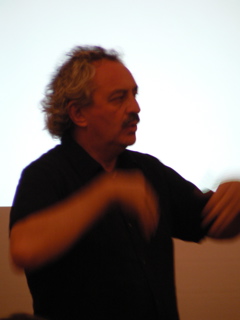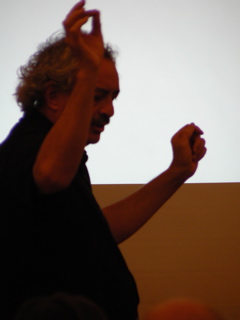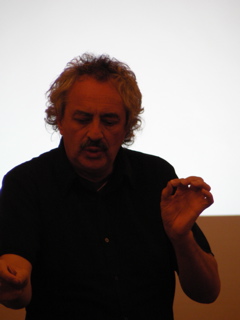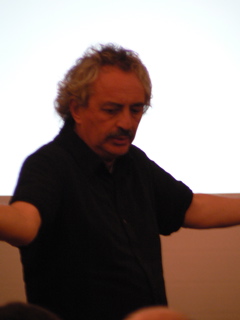First published in ReSource Magazine, Issue 8
It was always going to be an adventure — the first interview maverick therapeutic genius David Grove had given since 1996 (see: ‘And … what kind of a man is David Grove?‘). So maybe it wasn’t surprising to find myself dangling upside-down in a dark, sub-zero November car park on a psycho-active fairground ride. Maybe I should have expected another result, too: massive personal change at the deepest level. That’s what I got.

David is the creator of Clean Language, a set of simple questions which help clients explore their own metaphors. The facilitator’s ideas stay as far in the background as possible, the client’s words and gestures take centre stage. But his new work is causing an even bigger buzz. A packed house at his Saturday-night demonstration at the London NLP Conference in November was spellbound — but confused. We could see that big things were happening for the demonstration subjects. But what was really going on?
Executive coach Neil Scotton, of Redhill, Surrey, was one of the demo subjects that evening, and experienced something deep. He found it hard to put into words, though, even weeks later. “I have learned something, but I am not quite sure what. It was a mind-shift experience. “I didn’t end up with a to-do list. It’s like a much greater sense of purpose and being, feeling much more purposeful and together and — reassured, I suppose. It’s had a very positive influence on my decision making, a sense of peace in troubled times.”
Neil, director of research for the International Coach Federation, wants to find out more. “I would certainly recommend other people to experience it. I think there is something really important in there about the way in which we ask questions of each other and the way in which we can better understand each other.”
So, what is this process, exactly? It’s not tidily codified; it’s still shifting with every sweep of David’s imagination. It involves space, movement, and as few words as possible. It’s about staying Clean. It’s about running a system and allowing new information to emerge. In the version of it that was demonstrated that night, the client moved from space to space around the room, with David asking: “What do you know from that space there?”, “What does that space know?” and “Is there another space that you could move to?”
The mechanics seemed straightforward enough. David and one of his collaborators, Carol Wilson, outlined it in ReSource article few months ago: Emergent Knowledge and Clean Coaching.
But perhaps there was more to it than a simple exercise. David was noticing little details of the subjects’ body language, such as Neil tapping his watch. “The information we want is in that tap!” he declared. There was something unusual about the way David timed his questions and the subject’s movements.
From Neil’s point of view, it wasn’t all easy going. “One position was horrible!” he said. “I was burning up and my heart was going and I felt really out of control, ‘What the devil’s going on here?’. Like NLP it’s like a hammer — you can use it to make things, make things stick together and stay stuck. By the same token you can do a huge amount of damage. I’m reminded of when I was growing up in Kent my dad bought a chainsaw and I read the handbook that went with it. It said: ‘Accidents with chainsaws are seldom trivial.'”
So, what about this interview? By the time of the conference I’d been trying to pin David down for weeks, even though he’d agreed to the interview to promote a training he’s doing jointly with Wendy Sullivan in May.
I’d discovered that David was notoriously unpredictable; that he’d follow whatever grabbed his interest; that he’d vanish mysteriously and then appear without warning, rounding up a group for his latest enthusiasm. One minute he’d love to meet for lunch, the next he was sick, travelling, in Yorkshire, in France …
On that conference Saturday night he was charming, flirtatious, fascinating, enthusiastic – and apparently totally oblivious to the fact that it was ten o’clock and nobody had had any dinner. And the next day, when we finally sat down together, the charm was turned off completely. David was direct to the point of rudeness. Questions were met with hostility or an uncomprehending stare, making traditional interviewing impossible.
I was slightly tempted to walk away and talk to somebody civilised. But as a news journalist, the “Clean” principle is deeply ingrained in me: “People don’t want to hear how you feel or what you think. It’s not you or your stuff that’s important. They want to hear the person you’re interviewing.” And so he talked, and talked, and talked, while I took shorthand and did my best to follow a monologue dense with information, speculation, interest.
“In 1991, I set out to answer the question: ‘Where do people go when they dissociate?'” he explained. “I got the answer to that about five years ago. Now it’s about: ‘What do you do about that?'”
Part of the answer to his original question, which emerged from his work on healing trauma, had to do with the way people experience themselves as a collection of “parts”. The most comfortable state was for them all to be integrated, but there was no point in trying to force them together. His approach was intended to tease them apart even more, resulting in them reconfiguring themselves into a whole. “You can’t just bring stuff that has been split together again. The more you bring them together the more they repel. In fact, you need to split them more,”
he said.
In the work we’d seen demonstrated, called Clean Space and Emergent Knowledge, the nine basic Clean Language questions were reduced to just two or three, combined with movement to six different spaces. The facilitator’s role was to set the space up carefully so it was fully “psycho-active”, keep the process going until it was finished, and ensure that the subject stayed in each space for long enough. It was a trance-like experience for the subject, but there should be no suggestions from the facilitator. “That would be a hideous thing to do!”
He was convinced that the number six was important, with an almost mystical significance, and was finding sixes everywhere. Just as in the famous Stanley Milgram experiment, it was found that every person in the world is connected to every other through six people, ‘six degrees of separation’, all kinds of other networks had six as a key number. Excitedly, he told how he’d woken in the night and turned on a hotel TV, only to find a programme about whirling dervishes, a traditional “Gateway to God” using dance. Amazingly, they had six sequences. What a coincidence! That he’d seen it at all, and that it was another six!
“I always said there were six Clean Language questions, twenty years ago I said there were six.” And, he said, a network with six nodes would become an active system, from which totally new information can emerge. That meant that in Clean Space, six spaces must be visited and their information fully drawn out. And that in turn meant six points of view should be included in this article. It was obvious!
He talked on, and on, giving more and more details of the process, the possibilities, and the patterns he was finding. He was most excited by his “whirligig”. Instead of being able to walk about, subjects were strapped into a device in which they could be turned to different positions — upside down, sideways, wherever — as the exploration continued. The next version would have the person supported in a sort of duvet … or be suspended on a cherry-picker so it could be moved up and down, or from side to side … and he could measure their physical changes as they went …
And suddenly, we were heading back to the conference. I was trailing in David’s wake, trying to ask a few more questions … check details … and getting very little joy …
The facts, as I understand them, are these. David comes from New Zealand, and has European and Maori ancestry. He was working in business when he came across NLP in 1978. Then on one occasion he went along to an NLP business workshop to find it cancelled. The organisers persuaded him to join another group, and so David became interested in phobias and trauma.
He went on to work with NLP’s founders, to qualify as a Master Practitioner and to develop skills in Ericksonian hypnosis before walking away from NLP in 1981, during some of its darker days. He later took a degree in psychotherapy and eventually took a psychotherapeutic roadshow worldwide, demonstrating his “Inner Child” processes to a total of around 40,000 people.
More recently, Penny Tompkins and James Lawley codified Clean Language and produced the book Metaphors in Mind (2000). And in the last twelve months, David has been working with new collaborators, too, developing Clean Space, Emergent Knowledge and Clean Coaching methodologies.
Jo Hogg, organiser of the NLP Conference, has known David Grove since 1985. He’d put her in the whirligig during the Conference weekend. “I certainly got some change from being in there that was not on any conscious level. Literally by being reoriented I gained a different sense of connection to myself. How that worked I have no idea. What he is doing is tapping into an unconscious process. Some belief change techniques work on a conscious level, you are getting insights. With this you don’t get any insights, but you get a change.
“His thinking about how change works is an all-consuming passion for him. His is a truly original thinker pushing the boundaries in the field. I feel honoured to know him. “David has always been a law unto himself. Always inspirational – but he just does what grabs him in the moment. He is totally ‘in time’ and caught up with the latest ideas that are firing his imagination.”
And now it was my turn to be a demo subject. “I’ll put you in the whirligig!” David suddenly announced, before wandering off and leaving me hanging about for an hour!
The device, mounted on a trailer behind his estate car, had a hard, orange plastic seat suspended in the centre of three steel circles. It needed to be “driven” by David and a friend. I was freezing cold, confused, and nervous, not least because NLP’s intellectual heavyweight, Wyatt Woodsmall, had just taken a turn himself and was witnessing the entire process with a running commentary from David.
The effect is very hard to describe in words. It isn’t about language; it’s about movement and physical sensations. A particular orientation reminded me of the day after the London bombings when, in a spirit of “feel the fear and do it anyway” I had been dropped from a crane into a cargo net: “scad diving”. My body seemed to remember the whole jumble of emotions I’d felt at that time, all the fear and panic and stress of the previous day.
From there I was rotated into various other positions — upside down forwards, upside down backwards, looking out at the stars — before eventually being manoeuvred back to that “scad diving” position. Wow, what a difference! This time I was filled with excitement and exhilaration, whooping with joy. And once released from the device there was a peace, quietness, a sense of “You don’t have to do anything.”
David had to ask quite sharply, I think twice, for me to give some sort of verbal report to Wyatt. I muttered a few words. I have no idea if they made sense, and I didn’t care very much.
I didn’t care very much! About making sense! In front of Wyatt Woodsmall! Why was that so exciting? Again, it’s hard to explain.
Imagine for a moment, if you can, what it would be like to live a life dominated by intense fear around other people. Whenever you were not alone, all that mattered was controlling your feelings and concealing their physical symptoms. How could you look normal in a party? How could you sound normal in a meeting? How could you have sex? Share a house? What about job interviews or exercise classes? Now imagine that fear disappearing. The pressure lifting, the darkness clearing … breathing clear, fresh air … freedom …
For me, it was as profound as it gets. Released from my cage, over the next few weeks I discovered I could now take everything I’d learned in my personal development journey — NLP, hypnosis and so on — and easily make it work well for me.
But the adventure still wasn’t over. What about those six additional points of view? We heard from Jo Hogg and Neil Scotten above. Wendy Sullivan, Phil Swallow and John Farrell also agreed to chat. And finally … I interviewed Wyatt himself. I was excited, and I wasn’t afraid.
So, what’s the answer to the puzzle? What’s ‘really’ going on in David’s latest work? Much as it pains the journalist in me to admit it, it’s to do with the fact that people don’t experience the world as it really is. Each of us creates our own reality, by filtering what’s out there through what we believe.
What I think David is doing is seeking change by working directly with the reality that his clients experience on the inside, at the deepest level. Never mind that it’s not ‘true’, never mind it’s different to his and therefore seems wrong. He’s working with that part of the client that expresses itself through symbols, dreams, physical gestures, movement, and metaphors. And using these techniques, that part can resolve its deepest traumas, find its own solutions — and live happily ever after.
Wyatt Woodsmall, founder of the International NLP Trainers
Association experienced David Grove’s whirligig at the NLP Conference
“David Grove is like a mad scientist! It reminds me of the stuff Richard Bandler was doing in his earlier days, trying things other people might not be willing to try. I find I have as many questions as I have answers. A lot of NLP requires feedback from the client, whereas this technique is designed so that feedback is almost irrelevant. It’s like a mechanical thing — people go through the process and come out with changes.
The advantage of that sort of technique is that you can train anybody to do it. With things like wars and disasters, people are going through traumas that can be overwhelming. What if he could set up a couple of these whirligigs somewhere like New Orleans? It’s an interesting idea. If he can take care of traumas, which he claims to do, the evidence would be pretty dramatic.
Lawley and Tompkins have obviously done a good job in working with Clean Language and modelling that part of what David is doing. The whirligig, though, is a totally different ball game. If we could understand why these things work we might be able to come up with parallel techniques that don’t involve equipment.
And I am interested in modelling how he figured out how to do this. What was the intellectual process that allowed him to generate this? What is going on in his mind?”

Phil Swallow has worked with David Grove over the last six years. He is currently working on a new Clean Language video.
“David is constantly evolving what he is thinking about. His attention shifts and goes to something that might be related or it might be very different. As long as you are prepared for a fairly white-knuckle ride you are going to get a lot as you go along. I don’t take every bit as seriously as every other bit, and I periodically step off the ride and say: “Which of these things were really important?”
To people who are watching, whatever David is doing can seem terribly important. In fact once you have seen him do something like that a number of times, it’s like London buses, there will be another one along in a minute. There will still be good busses and they will take you to interesting places, but it’s not necessarily the best mode of transport. You may have to wait around quite a while.
“Clean Space is one of the major things – the least kind of intervention from the facilitator and yet gets the most out of the client.”

John Farrell has worked with David since June 2005
“I think this is actually going to change NLP. It’s not like Tony Robbins, where people get a shot in the arm and it wears off. With David’s stuff the changes stick. It makes a lasting difference.
We are developing Authentic Leadership courses based on David’s stuff, and it’s blowing the business people away. We got absolutely amazing results from a pilot course we ran — we had seven couples on it and they all experienced absolutely amazing shifts. Weeks later you can see what’s changed, they are coming across differently and they can see people reacting to them differently.
We did some work with him in early December and then took him to the airport to go back to New Zealand. A couple of weeks later he was there on the doorstep, and he was with us for a week over Christmas and New Year. The latest thing he was doing was to reduce the questions down to just one: ‘Now I am asking my next question’.”

Wendy Sullivan of cleanchange.co.uk is the UK’s biggest trainer of Clean Language
“I think that David is the most creative individual that I know. His track record gives plenty of evidence that he is able to tap into things that are core to what makes people tick. Working with him makes it clear how very different a thinking style rampant creativity requires, and it has also made me aware its probably not easily turned on and off. The wonderful aspect is all the new thoughts, new paradigms, advances in the field and so on. But there isn’t really space for the mundane things in life, which can be squeezed out.
People like David, with a genius level of creativity, have different challenges in life from more mundane mortals, and if one is a more mundane mortal working with someone who is wonderfully creative then there are challenges, because the different thinking styles mismatch. When one hangs around him enough one starts to appreciate that he is just living life in a very different world.”

© 2006 Judy Rees
 Author, trainer and consultant Judy Rees is passionate about effective communication, especially in business and online. She is an expert in the questioning and listening technique Clean Language, and the co-author (with Wendy Sullivan) of the category bestseller Clean Language: Revealing Metaphors and Opening Minds. Judy is fascinated by the most neglected, yet possibly most important, aspect of communication: listening. See judyrees.co.uk.
Author, trainer and consultant Judy Rees is passionate about effective communication, especially in business and online. She is an expert in the questioning and listening technique Clean Language, and the co-author (with Wendy Sullivan) of the category bestseller Clean Language: Revealing Metaphors and Opening Minds. Judy is fascinated by the most neglected, yet possibly most important, aspect of communication: listening. See judyrees.co.uk.








